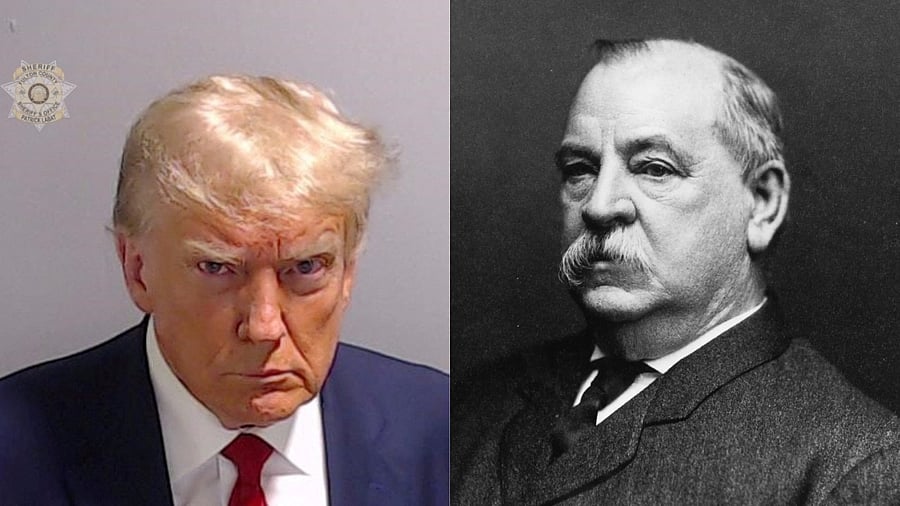
(L-R) A file photo of President-elect Donald Trump and a picture of former President Grover Cleveland.
Credit: Reuters File Photo and The White House
Donald Trump in becoming the 47th President of the United States has made history in two ways -- the 78-year-old is now the oldest person to be elected president and he has become the second person in the history of America to lose a re-election Presidential run and then make their way to the Oval Office.
The first was Grover Cleveland who was the 22nd and 24th president of the United States, serving two non-consecutive terms from 1885 to 1889 and again from 1893 to 1897.
Here’s what you need to know about his presidency and political influence:
Background and Early Career
Birth and Education: Born on March 18, 1837, in Caldwell, New Jersey, Cleveland came from a modest background. He became a lawyer after studying in Buffalo, New York.
Political Rise: Cleveland first gained political attention as the Mayor of Buffalo, where he earned a reputation for battling corruption. His efforts against political machine practices won him a following and propelled him to the governorship of New York.
First Presidential Term (1885-1889)
Election of 1884: Cleveland ran as a Democrat against Republican James G. Blaine. Cleveland won a close race, partly due to a backlash against Blaine's involvement in political scandals.
Policy Highlights:
Anti-Corruption Stance: Cleveland was known as a reformer who fought against political corruption. He was a strong advocate for merit-based government jobs, laying foundations for civil service reform.
Limited Government Spending: Cleveland vetoed numerous bills he saw as excessive or benefiting special interests, believing in minimal government intervention. His opposition to high tariffs was part of his broader economic philosophy.
Interstate Commerce Act: In 1887, Cleveland supported the act to regulate railroads and curb unfair practices, setting a precedent for federal regulation of business.
Defeat and Comeback (1889-1893)
Election of 1888: Cleveland ran for re-election but lost to Republican Benjamin Harrison, despite winning the popular vote. Harrison won the electoral vote, partly due to strong support in swing states.
Between Terms: After his defeat, Cleveland returned to private life but remained a popular figure in the Democratic Party.
Second Presidential Term (1893-1897)
Election of 1892: Cleveland returned to politics to challenge President Benjamin Harrison, his successor, winning the rematch largely due to public dissatisfaction with economic conditions.
Major Challenges:
Economic Depression: Shortly after his second inauguration, the Panic of 1893 hit, leading to a severe economic depression. Cleveland’s response focused on maintaining the gold standard and reducing government debt, which some believed worsened conditions.
Labour Unrest: Labour strikes, most notably the Pullman Strike of 1894, became widespread due to economic hardship. Cleveland’s decision to use federal troops to break the strike stirred controversy, as it was viewed as prioritising business interests over workers’ rights.
Silver vs Gold Debate: Cleveland opposed the free coinage of silver, preferring to keep the gold standard to maintain a stable economy. This stance alienated the pro-silver factions within his own party.
Hawaiian Annexation: Cleveland opposed the annexation of Hawaii, rejecting a treaty initially proposed by Harrison. He later sent a commissioner to investigate the situation, finding the Hawaiian monarchy had been illegally overthrown.
Legacy and Impact
Nonconsecutive Terms: Cleveland’s split terms highlight his influence over two different political eras and his unusual place in presidential history.
Reputation for Integrity: Known as “Grover the Good,” Cleveland was respected for his moral rigour, vetoes against self-serving bills, and resistance to popular but fiscally irresponsible policies.
Views on Limited Government: Cleveland’s commitment to a hands-off approach in economic matters reflected classical liberal values, but his strict stance against government intervention drew criticism during economic hardships.
How America has remembered Cleveland
Grover Cleveland is remembered as a conservative reformer who prioritised government accountability, fiscal conservatism, and civil service reform. However, his responses to economic crises and labour strikes were divisive and led to a decline in his popularity. His legacy is marked by his rare nonconsecutive terms, steadfast moral principles, and influence on Democratic policies in the late 19th century.
Trump has got the first one down, and what the next four years bring remains to be seen.
(This article has been generated using AI and edited by DH Web Desk)
